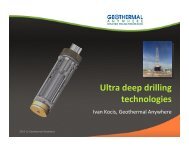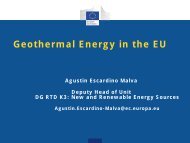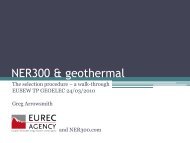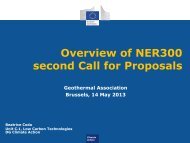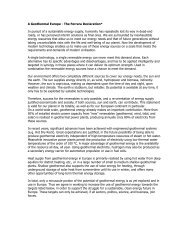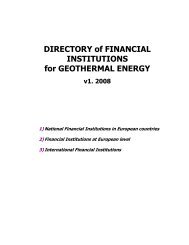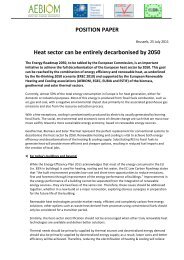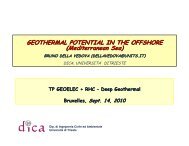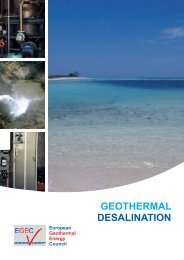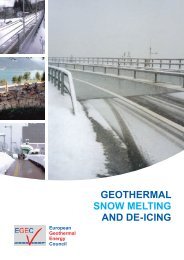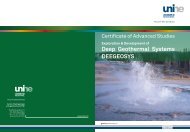Strategic Research and Innovation Agenda for Renewable ... - EGEC
Strategic Research and Innovation Agenda for Renewable ... - EGEC
Strategic Research and Innovation Agenda for Renewable ... - EGEC
Create successful ePaper yourself
Turn your PDF publications into a flip-book with our unique Google optimized e-Paper software.
5<strong>Strategic</strong> <strong>Research</strong> <strong>and</strong> <strong>Innovation</strong> <strong>Agenda</strong> <strong>for</strong> <strong>Renewable</strong> Heating & CoolingRHC applications to industrial processes5.5.1 <strong>Research</strong> <strong>and</strong> innovation priorities with impact in the Short TermCCT.12ObjectiveEnhanced industrial compression heat pumpsDevelopment of advanced compression refrigeration cycles based on novel working fluids<strong>for</strong> use in medium temperature industrial applications (condensation temperatures up to 150 °C<strong>and</strong> evaporation temperatures up to 100 °C). Applications of these novel heat pumps includeprocess heat generation as well as waste heat recovery in industrial processes yieldingsubstantial increases in energy efficiency.State-of-the-artR&D topics to be addressed in this context comprise:• new working media (low GWP, non-inflammable) or natural refrigerants (water),• improved compressors <strong>and</strong> lubrication methods <strong>for</strong> high evaporating temperatures(up to 100°C),• heat exchangers with improved design <strong>for</strong> direct using of condensing gases(flue gas, exhaust air, drying processes, etc.).Current vapour compression systems deliver heat at a maximum temperature of ~80 °C.Targets • Carnot efficiency of at least 0.35• At least 2 demonstration projects should be realised by 2020.• Condensation temperatures up to 150°C• Temperature lift up to 60 K• Energy saving up to 30%• Cost target heat pump unit: 200 to 300 Euro/kWType of activity20% <strong>Research</strong> / 60% Development / 20% DemonstrationCCT.13ObjectiveProcess integration, optimisation <strong>and</strong> control of industrial heat pumpsDevelopment <strong>and</strong> demonstration of electrically <strong>and</strong> thermally driven heat pumps in individualindustrial applications as well as in combination with district heating <strong>and</strong> cooling networksincluding thermal energy storage.R&D topics to be addressed comprise:• classification of processes (temperature levels, time-based energy dem<strong>and</strong>, etc.),• process integration of industrial heat pumps (control <strong>and</strong> hydraulic design),• impact of heat pumps on existing process (dynamic behaviour),• selection of components (refrigerant, compressor, heat exchangers etc.) <strong>for</strong> theprocess identified,State-of-the-art First prototypes of compression heat pumps with evaporation temperatures of up to 40°C<strong>and</strong> condensation temperatures of up to 80°C are available but still need to be demonstrated.First prototypes of absorption heat pumps using new working pairs without crystallisationeffects are available, but not demonstrated yet in real-life operating conditions.Targets • 5 lighthouse projects with a capacity of minimum 1 MWth implemented by 2020• Compression heat pump: minim sCOP of 5, energy savings of at least 30%• Absorption heat pump: minimum sCOP of 1.5; energy savings of at least 50%• Cost target on system level <strong>for</strong> electrically driven heat pumps (unit plus installation):400 to 500 Euro/kWType of activity30% Development / 70% DemonstrationCCT.14ObjectiveImprovements in Underground Thermal Energy Storage (UTES)Improvement of system concepts <strong>and</strong> operational characteristics of UTES systems, investigationof optimum integration of UTES into industrial processes. In addition, the thermal efficiency ofstorage in different geological conditions should be increased <strong>and</strong> the thermal behaviour betterunderstood (cf. GEO.6).Of high importance <strong>for</strong> the reliable operation of UTES is R&D into water treatment technologypreventing clogging, <strong>and</strong> into component selection to prevent scaling <strong>and</strong> corrosion 61 .State-of-the-artTargetsType of activityThe first UTES application were in fact used <strong>for</strong> industrial purposes, providing cold to thetextile industry near Shanghai in China in the 1960s. Since then, system concepts have beendeveloped <strong>and</strong> geological <strong>and</strong> hydrogeological constraints investigated. UTES today aredesigned <strong>and</strong> operated following established routines, however further improvements are stillpossible <strong>and</strong> some aspects like hydrochemistry <strong>and</strong> water treatment await satisfactory solutions.• Increased energy efficiency in industrial batch processes by 25 % through heat storagein the underground.• Improve system reliability <strong>and</strong> plant longevity at elevated temperatures.40% Development / 60% Demonstration61For more in<strong>for</strong>mation,cfr. RHC-Plat<strong>for</strong>m (2012),<strong>Strategic</strong> <strong>Research</strong> Priorities<strong>for</strong> Geothermal Technology,Chapter 3.2.2.58



